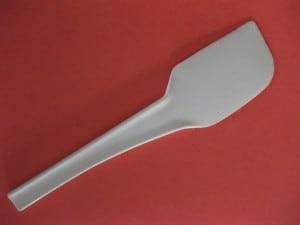When I’m cooking, I find myself using the same inexpensive tools again and again. I like gadgets as much as the next person, but I try not to clutter the kitchen with rarely used items.
These are my favorite low-tech kitchen tools:
1.Plastic spatulas. These can be found for cheap in housewares stores, and are good for emptying containers and spreading filling. I use the rounded edge for bowls, and the square edge for the bottom of the food processor. Scraping out remainders of food saves money and makes cleanup easier.
2. Sprayers. My mother cleaned cabinets with a bucket of soapy water. But sprayers save water and soap because they evenly distribute a thin layer of cleaning solution. Buy empty sprayers or recycle old ones by filling with your own cleaning solution. The spray gets into the air, so you may prefer diluted vinegar over manufactured chemicals. Give small kids a sprayer of plain water so they can help too. To clean cabinets and appliances spray, wait a few minutes for dried-on food to soften, and wipe dry with a rag. I keep sprayers in the kitchen and bathrooms, along with an extra as they often break.
3. Rags. I make my own rags from old cotton undershirts, towels, and sport socks. Absorbent terry socks, cut down to the toe, are the best, and work much better than paper towels. My clean rags live in a kitchen drawer, while dirty rags go in a bucket to be washed every week or two. Read Trent’s take on eliminating paper towels.
4. Scissors. I keep a pair of children’s scissors handy to open bags of milk (only in Israel) and other plastic packages. Another pair goes in the bathroom to open bags of detergent and cut threads and labels.
5. Wooden spoons. I keep an assortment for stirring soups and pastas, and for mixing batters and casseroles. Have at least one that is longer than the height of your tallest pot.
6. Stacks of plastic and glass bowls of various sizes. Did you ever notice, on a cooking show, how the chef is surrounded by conveniently placed bowls, filled with the exact amount of each ingredient to add to the pan at the appropriate time? That used to seem like extra work to me, but it turns out to be the most efficient even if you have to prepare the ingredients yourself.
If you enjoyed this post you may also like:


I am quite proud of myself! I can identify fully which each one of your items, Hannah! With a little difference in number three. I wash rags with each load of laundry. My top loader, which is open whenever not running (I’ve never had a smelly washer), is just off the kitchen. I throw the rags as they are used right into the washer and they get done with the next load. I don’t fold the rags, I just throw them back into the basket that’s on top of the the freezer in the laundry area. A few extra rags are kept just under each kitchen sink.
I know you’re probably going to say that you wash the rags with bleach and hot water, but I’m not so worried about that. When the rags start coming out of the laundry looking really bad, I switch them for one time toilet cleaning use and throw them away.
Besides the usual undershirt rags, I go through the clothes that my children discard, before sending them to the gmach, and pull out all cotton knitwear. T-shirts, etc. Doesn’t matter if it’s in good condition, it’s mine to use as rags.
Now, what did this have to do with cooking, LOL!!
Debbie, I would love to talk about laundry here but I try to stay on topic! No, no bleach nor hot water for me. But I do do the rags in a “normal” load as opposed to delicate. And the wear and tear is noticeable.
using wood spoons has a few advantages, you just need to mark them well for meat and dairy – but they really keep the pots from getting scraped up. Our teflon pans keep really well b/c we use wood on them.
I love the trick of the little glass bowls. In our throwaway society, I would be more likely to use small paper cups. In terms of rags, I can identify with Debbie. I like using rags made from old knit shirts and I like remembering who wore them and how they looked.
I grew up in Canada where milk also comes in bags so a scissor is also necessary in the kitchen there. I no longer use paper towels in my kitchen (but keep a roll around for other family members). I now use microfiber cloths which I bought for 4 for 10 shekels and they clean up amazingly well.
What is the advantage of a wooden spoon over a metal spoon? I always use a metal spoon (we have no teflon pots) — what am I missing out on?
Big ones for big pots and bowls are very cheap. They’re good for mixing batters, and they don’t get hot. Bonus: They’re biodegradable.
(Hannah, I really like your site!) My husband, when he cooks (which is most of the time), always does it the efficient way: he measures and preps the different ingredients in various bowls or ramekins, so that when it is time to put each one in, it is ready.
It really is a more efficient way of preparing and cooking a recipe in the long run.
I learned to do the same (ok, he taught me!) when I make and bake challot for Shabbat.